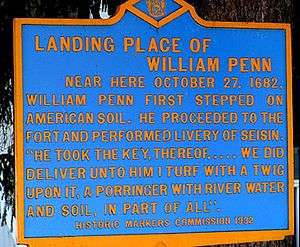Livery of seisin
Livery of seisin is an archaic legal conveyancing ceremony, formerly practiced in feudal England and in other countries following English common law, used to convey holdings in property. The term "livery" is related to, if not synonymous with, the word "delivery" as used in modern contract law. The common law in those jurisdictions once provided that a valid conveyance of a feudal tenure in land required the physical transfer by the transferor to the transferee, in the presence of witnesses, of a piece of the ground itself, in the literal sense of a hand-to-hand passing of an amount of soil, a twig, key, or other symbol.
Varieties
Livery of seisin could refer to either:
- Livery in deed, whereby the parties actually went on to the land, and the transferor symbolically delivered possession of the land by handing over a twig or a clump of earth to the recipient
- Livery in law, whereby the parties went within sight of the land and the transferor declared to the recipient that possession was being given, followed by the recipient entering onto the land
The symbol of livery for a house was the door's ring or hasp; for mills, the "clap and hopper"; for a church, a psalm-book and keys, and so on.
Legend
According to Widukind of Corvey, a Saxon in Thuringia was approached by a local who asked to buy the Saxon's torc and bracelets. The local offered him a pile of dirt in exchange for the ornaments, which the Saxon eagerly accepted. The Thuringians thought they had made a good deal until the Saxons claimed the entire country on the basis that the dirt had been a livery of seisin, and made their legal claim good by force of arms.
Turf and twig ceremony

The turf and twig ceremony dates from the feudal era, but was used regularly in early colonial America, allowing the English to take sovereign possession over unclaimed lands. The process has taken several forms over the centuries. Bernulf Hodge in A History of Malmesbury describes the process, discontinued in the late 17th century, as follows:[1]
"The lucky new Commoner goes to his "given" acre and cuts a turf from the selected site and drops two shillings in the hole made. The High Steward then twitches him with a twig and sticks the twig in the turf, then hands it to him saying, "This turf and twig I give to thee, as free as Athelstan gave to me, and I hope a loving brother thou wilt be." The High Steward then takes the money out of the hole and the new landowner replaces the turf."
Continuing ecclesiastical use
A vestige of the procedure survives in the act by which a candidate is admitted to the office of incumbent in the Church of England. Canon C11 provides:[2]
- The bishop, after giving institution to any priest, shall issue directions for induction to the archdeacon or other the person to whom induction belongs, who shall thereupon induct the said priest into possession of the temporalities of the benefice.
- The archdeacon or other such person, when he makes the induction, shall take the priest who is to be inducted by the hand and lay it upon the key or upon the ring of the church door, or if the key cannot be had and there is no ring on the door, or if the church be in ruins, upon any part of the wall of the church or churchyard, at the same time reading the words of induction; after which the priest who has been inducted shall toll the bell to make his induction public and known to the people.
See also
References
- ↑ http://davidforward.net/menus/history/a-history-of-malmesbury/#twig
- ↑ http://www.churchofengland.org/about-us/structure/churchlawlegis/canons/section-c.aspx#Head1-71